Healing Foods: Garlic


Sitting on the pantry shelf, a garlic bulb seems innocent enough. It doesn’t need refrigeration to stay fresh and has no pungent odor to speak of. But when the cloves it contains are sliced, diced, or crushed and exposed to air, a series of oxidative chemical reactions occurs, transforming the inert chemical alliin into some 200 biologically active compounds, including allicin.
David W. Kraus, PhD, of the University of Alabama at Birmingham, and his colleagues showed that human red blood cells convert allicin and other garlic compounds to hydrogen sulfide, one of the substances that cause garlic breath. Hydrogen sulfide was found to relax blood-vessel cells, helping maintain their flexibility and possibly protecting against hypertension. “Garlic reduces coronary calcification (which contributes to hardening of the arteries), it reduced cholesterol beyond that of statin drugs (e.g., Lipitor) in one study, and it may lower the risk of gastrointestinal and prostate cancers,” explains Richard Rivlin, MD, of the Weill Medical College of Cornell University in New York, who has spent years studying the health properties of the “stinking rose.”
Garlic has been used to treat a variety of ills for thousands of years — in ancient China, Egypt, and Rome through Medieval Europe— to aid digestion, fight parasites, relieve respiratory problems, and more. In the 19th century, Louis Pasteur described garlic’s antibacterial properties; and during World War I, Albert Schweitzer, MD, recommended it for dysentery. “It was called the Russian penicillin during World War II because of its effectiveness against infections,” notes Rivlin.
Related: The Health Benefits of Garlic
More recently, research has supported garlic’s cold-fighting properties. In a 2001 study of 146 people, those taking aged garlic extract for 12 weeks between November and February were almost two-thirds less likely to catch colds compared with those taking a placebo. The study, published in Advances in Therapy, also found that garlic takers who did catch colds recovered faster than those in the placebo group. Many of garlic’s benefits are a result of the multiple biological compounds formed from alliin. In addition, garlic can efficiently absorb selenium from soil. Selenium, which has anticancer efficacy, is essential for the body to produce glutathione peroxidase, an enzyme that helps the liver break down toxins. Garlic also contains components that form glutathione, the most powerful antioxidant manufactured by the human body.
Supplement Savvy
Supplements such as aged garlic extracts, which have been widely tested for cardiovascular benefits, are processed to yield specific levels of biologically active compounds, making it difficult to extrapolate a recommended dose in basic food form. Your best bet: Use garlic liberally in cooking, aiming to consume several cloves a day. Rivlin’s favorite way to eat a whole head of garlic (about 12 cloves) in a single dose is adapted from research at Penn State University: He slices the top off of a head of garlic to expose it to air for 20 to 30 minutes before roasting for 30 minutes in a 350°F oven, then spreads the soft, smoky-sweet pulp from the cloves on whole-wheat bread. And because roasting helps temper the pungency of the garlic, this easy home remedy (which happens to make a delicious hors d’oeuvre) won’t hurt your chances at romance, either.
What To Look For: Every form of garlic, including supermarket garlic powder, seems to have some health benefits. However, most studies on garlic supplements have been conducted on aged garlic extract.
How To Take It: Standard daily dosages of aged garlic extract range from 700 to 2,000 milligrams.
Safety: Garlic and garlic extract are on the FDA’s GRAS (generally recognized as safe) list. Check with your physician before supplementing with garlic if you take blood-thinning drugs or are scheduled for surgery in the near future. Garlic extract’s safety for young children and pregnant or nursing women has not been determined.